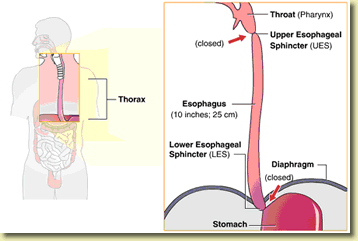

| Esophageal Motility Study |
Esophageal motility study (esophageal manometry, esophageal function study) is a test to measure the pressure inside the lower part of the esophagus.

How is the Test Performed
When you swallow, muscles in your esophagus contract to help push food toward your stomach. Valves, or sphincters, inside the esophagus open to let food and liquid through, and then close to prevent food, fluids, and gastric acid from moving backward. The sphincter at the bottom of the esophagus is called the lower esophageal sphincter or LES.
During esophageal manometry, a thin, pressure-sensitive tube is passed through your mouth or nose and into your stomach. Once in place, the tube is pulled slowly back into your esophagus.
When the tube is in your esophagus, you will be asked to swallow. The pressure of the muscle contractions will be measured along several sections of the tube.
While the tube is in place, other studies of your esophagus may be done. The tube is removed after the tests are completed. The test takes about 1 hour.
How Should I Prepare for the Procedure?
You should not have anything to eat or drink for 8 hours before the test
How will the Test Feel?
You may have a gagging sensation and some discomfort when the tube is put into place
Why is the Test Performed?
The purpose of esophageal manometry is to see if the esophagus is contracting and relaxing properly. The test helps diagnose any swallowing problems. Your health care provider may request that this test be performed if you have symptoms of gastroesophageal reflux disease (GERD).
Normal Results
The LES pressure and muscle contractions are normal when you swallow.
What do Abnormal Results Mean?
Abnormal results may indicate the following: